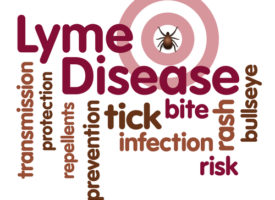Lyme disease is often called the “great imitator.” That’s because the symptoms of this bacterial infection (Borrelia burgdorferi), which is usually spread through tick bites, can be so diverse that it is often mistaken for a host of other conditions, such as chronic fatigue, multiple sclerosis or other autoimmune diseases, fibromyalgia, and even hypochondria. It may take years before a correct diagnosis of Lyme disease is made, and by that time, symptoms are severe and notoriously hard to treat.
Lyme Disease Finally Diagnosed
This was certainly the experience of N.B. A few years ago, this active and healthy 29-year-old began experiencing numbness and stiffness on his left side. When he started having balance problems as well, he saw a doctor who, after much testing and evaluation, diagnosed him with transverse myelitis, an inflammatory disorder of the spinal column. This was the start of a rotating cycle of diagnoses that included lupus, Devic’s disease, demyelinating polyneuropathy, and multiple sclerosis. When steroids and intravenous immunoglobulin (IVIG)—typical treatments for these autoimmune disorders—failed to help, additional tests were run, and N.B. was finally told he had Lyme disease.
Conventional Treatments for Lyme Disease Didn’t Work…
Once N.B.’s diagnosis of Lyme disease was established, he was treated with heavy doses of antibiotics and had marked improvements. The antibiotics were eventually stopped, however, and he immediately went further downhill. Shortly thereafter, he had minimal use of his left hand, was unable to stand or walk without a cane, and was forced to use a wheelchair at times. His physician was running out of options, so he recommended that N.B. come to Whitaker Wellness.
…But Innovative Therapies at Whitaker Wellness Did
We treated him with hyperbaric oxygen, EECP, intravenous vitamin C, and glutathione. After two weeks, he had regained some of his balance, partial use of his left hand, and he was able to walk 50 feet without assistance. Because N.B. didn’t have access to these therapies back home, he returned to the clinic six months later for additional treatment.
After his second round of treatment, N.B.’s balance and stability steadily improved. The dragging of his left leg lessened and he could walk 100 yards on his own. He was very encouraged by his progress and optimistic about the future. And so are we.
How to Get Treatment for Lyme Disease
If you have Lyme disease—or a cluster of misdiagnosed symptoms like N.B. did—come and see us at the clinic. We can help. Just call (866) 645-2064 or fill out this form for a complimentary consultation with one of our friendly and knowledgeable Patient Services Representatives.


